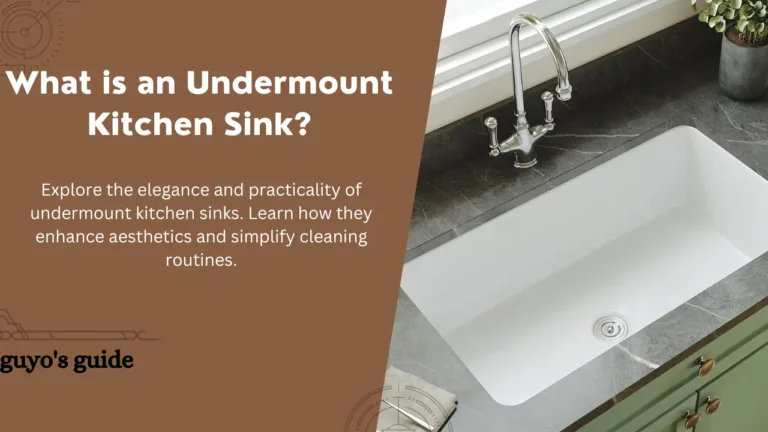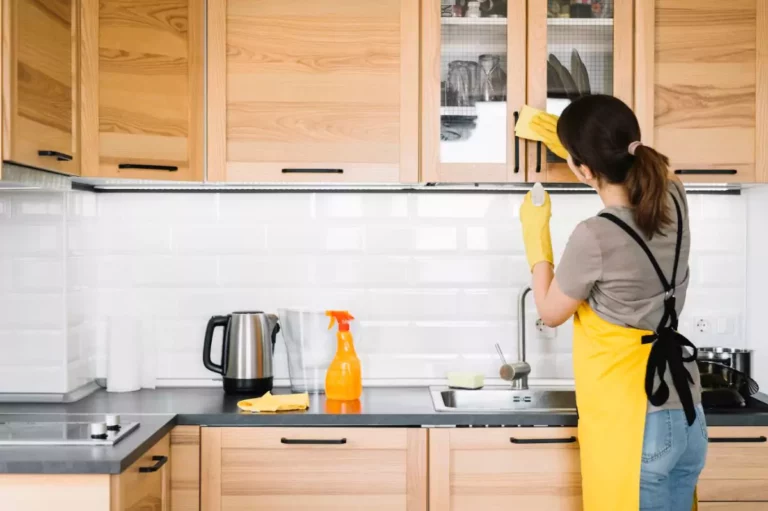How to Clean a Kitchen Sink Drain Like a Pro (Ultimate Guide)

Some of the links in this post are affiliate links, meaning, at no additional cost to you, We will earn a commission if you click through and make a purchase.
Having a clogged kitchen sink drain can be a major inconvenience, making it difficult to wash dishes and causing standing water to accumulate in the sink.
While it may be tempting to reach for harsh chemical cleaners, there are several natural and effective ways to clean and unclog your kitchen sink drain.
Since cleaning kitchen sink drains can be critical for others, this article will cover a few simple methods for keeping your sink drain running smoothly.
Let’s get started.
How to Clean a Kitchen Sink Drain Step-by-Step
Cleaning a kitchen sink drain is essential to maintain proper hygiene and prevent clogs and unpleasant odors. Here’s a step-by-step guide to help you through the process:
Materials you’ll need:
- Rubber gloves
- Baking soda
- White vinegar
- Boiling water
- Salt
- Plunger
- Drain brush or pipe cleaner.
- An old toothbrush or small scrub brush
- Lemon or orange peels (optional for a fresh scent)
Step 1: Remove any visible debris
Wearing rubber gloves, remove any large debris or food particles you can see from the sink drain. Throw them in the trash or compost, depending on the waste.
Step 2: Prepare a baking soda and white vinegar mixture

Gently Pour half a cup of baking soda down the sink drain. Follow this up with half a cup of white vinegar. The mixture will fizz, which helps break down grease and grime.
Step 3: Wait and let the mixture work
Simply allow the baking soda and vinegar mixture to sit in the drain for at least 15 to 30 minutes. This gives it enough time to work its way through the drain, loosening and dissolving buildup.
Step 4: Boil water
While you are waiting, bring a pot of water to a boil. You’ll use this hot water to flush out the drain.
Step 5: Pour the boiling water down the drain
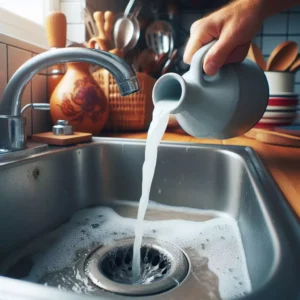
Pour the boiling water down the drain. This will help flush away the dissolved grime and push any remaining debris further down the pipes.
Step 6: Add salt for extra cleaning power

For particularly stubborn buildup, you can add half a cup of salt to the drain before pouring the boiling water. The abrasive nature of the salt will help scour away the gunk.
Step 7: Use a plunger
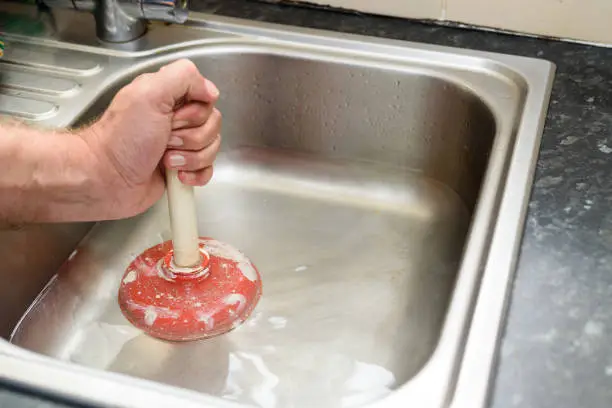
If the sink drain is still clogged or draining slowly, use a plunger to try and dislodge the blockage. Fill the sink partially with water to cover the plunger’s bell. Place the plunger over the drain and plunge vigorously several times.
Step 8: Use a drain brush or pipe cleaner
If there’s still resistance, you can use a drain brush or pipe cleaner to physically remove any remaining debris or buildup. Push it gently into the drain and twist it around to catch anything clogging the pipes.
Step 9: Scrub the drain stopper
Remove the drain stopper or strainer (if applicable) and clean it separately. Use an old toothbrush or small scrub brush to clean any accumulated grime.
Step 10: Freshen up with citrus
For a pleasant scent, consider grinding lemon or orange peels in the garbage disposal or dropping them down the drain.
Step-by-step on How to Use a Drain Cleaner
Using a drain cleaner can generally be an effective way to tackle stubborn clogs and buildup in a kitchen sink drain. There are various types of drain cleaners available, including chemical-based cleaners and enzyme-based cleaners. Here’s a step-by-step guide on how to use a drain cleaner properly:
Materials you’ll need:
- Rubber gloves
- Drain cleaner (chemical or enzyme-based)
- Boiling water
- Bucket (if you have a double sink)
Step 1: Read the instructions
Before using any drain cleaner, carefully read and follow the manufacturer’s instructions and safety guidelines on the product label. Different types of drain cleaners may have specific usage instructions.
Step 2: Protect yourself
To protect your hands from any splashes or potential contact with the drain cleaner, it is recommended that you wear rubber gloves.
Step 3: Clear the sink
Remove any standing water from the sink. If you have a double sink, block the other drain with a stopper or cover it with a wet cloth to create a seal.
Step 4: Pour the drain cleaner
Gently pour the recommended amount of drain cleaner directly into the kitchen sink drain. Be cautious not to spill it on the surrounding areas or yourself.
Step 5: Wait
Allow the drain cleaner to work as per the instructions on the product label. Typically, you’ll need to wait for several minutes, allowing the chemicals or enzymes to dissolve the clog or break down the buildup.
Step 6: Flush with boiling water
After the waiting period, carefully pour boiling water down the drain. The hot water helps to flush away the dissolved clog and drain cleaner residue.
Step 7: Follow up if necessary
In some cases, especially for severe clogs or large buildup, you may need to repeat the process or use a plumbing snake or auger to physically remove the remaining debris.
Step 8: Rinse and clean
Once the clog is cleared, rinse the sink thoroughly with hot water. You can also clean the sink surface and drain stopper/strainer using mild dish soap or kitchen cleaner.
Step 9: Regular maintenance
To prevent future clogs, consider using a drain stopper or mesh strainer to catch food particles before they go down the drain. Also, perform regular maintenance by using enzyme-based drain cleaners to keep the drain lines clear and prevent buildup.
Important Safety Tips:
- Never mix different types of drain cleaners or use them simultaneously. Combining certain chemicals can produce harmful fumes or reactions.
- Do not use a plunger or any other mechanical tool immediately after using a chemical drain cleaner, as it may cause splashing or release harmful fumes.
- Store drain cleaners out of reach of children and pets, following the manufacturer’s storage instructions.
What is the Best Drain Cleaner?
Here are the best drain cleaners you can consider buying today:
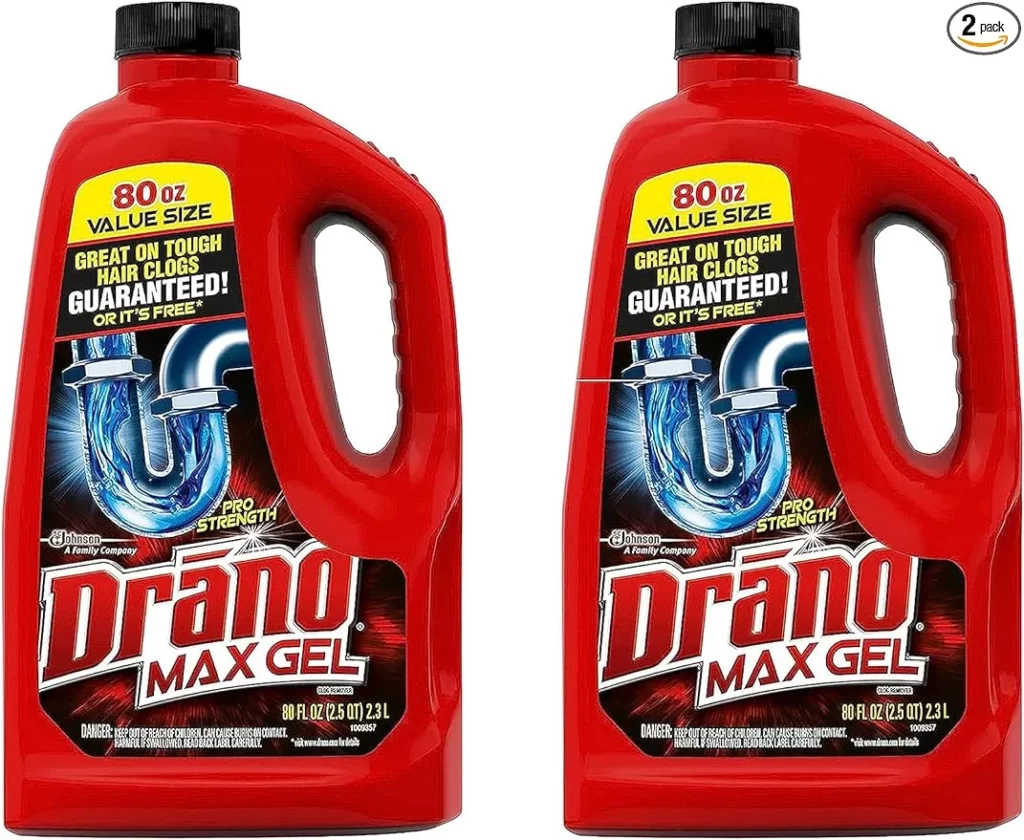
Amazon

Amazon
How Do I Remove Gunk From My Kitchen Sink Drain?
If you have gunk or buildup in your kitchen sink drain, here are some steps you can follow to remove it:
- Start by removing any large debris or blockages from the drain, such as food particles or small objects. You can use a pair of tongs or a plunger to remove these blockages.
- To clear your drain, combine equal amounts of vinegar and baking soda in a bowl. Once mixed, pour the solution down the drain and let it sit for approximately 30 minutes. This will effectively break down and remove any built-up grease or dirt.
- After about 30 minutes, flush the drain with hot water. You can use a kettle or a pot of hot water for this.
- If you still have a clogged drain or the gunk is still present, you can use a drain cleaner or a chemical cleaner specifically designed for kitchen sinks. Follow the manufacturer’s instructions on the product carefully, as these cleaners can be corrosive and may produce harmful fumes.
- If the drain is still clogged or the gunk is still present after using a chemical cleaner, you may need to use a manual auger, also known as a plumbing snake, to break up and remove any remaining blockages.
- To prevent future buildup, be sure to keep food particles and other debris out of the drain, and consider using a drain strainer or sink basket to catch any small objects that may accidentally go down the drain. Regularly using a natural drain cleaner, like a mixture of white vinegar and baking soda, can help maintain the cleanliness and clarity of your drain.
FAQs
How often should I clean my kitchen sink drain?
It is recommended to clean your drain at least once a month to prevent buildup and avoid clogs.
Can I simply use a chemical drain cleaner to clean my sink drain?
While chemical drain cleaners can generally be effective, they are also harsh on the pipes and the environment. It’s better to use natural cleaning methods with baking soda and vinegar.
Can I use a plunger to clean the sink drain?
Yes, a plunger can be effective in dislodging minor clogs in the sink drain. Make sure to use a sink plunger, which has a flat bottom that covers the drain completely.
What if the clog is more severe and the plunger doesn’t work?
If the plunger does not work, you can attempt to resolve the issue by using a drain snake or auger. These tools can help you reach deeper into the pipe, allowing you to effectively remove the clog.
Wrap Up
By following these tips and staying on top of regular maintenance, you can enjoy a fully functioning and clean kitchen sink drain for years to come.
If you are worried about damaging your drain pipes, you can simply hire a professional plumber to deep clean your kitchen sink drain, unclog the garbage disposal, or install any part of the kitchen sink you want.
Hopefully, this article has been helpful to you and has shown you the DIY step-by-step process to clean your kitchen sink drain professionally.


